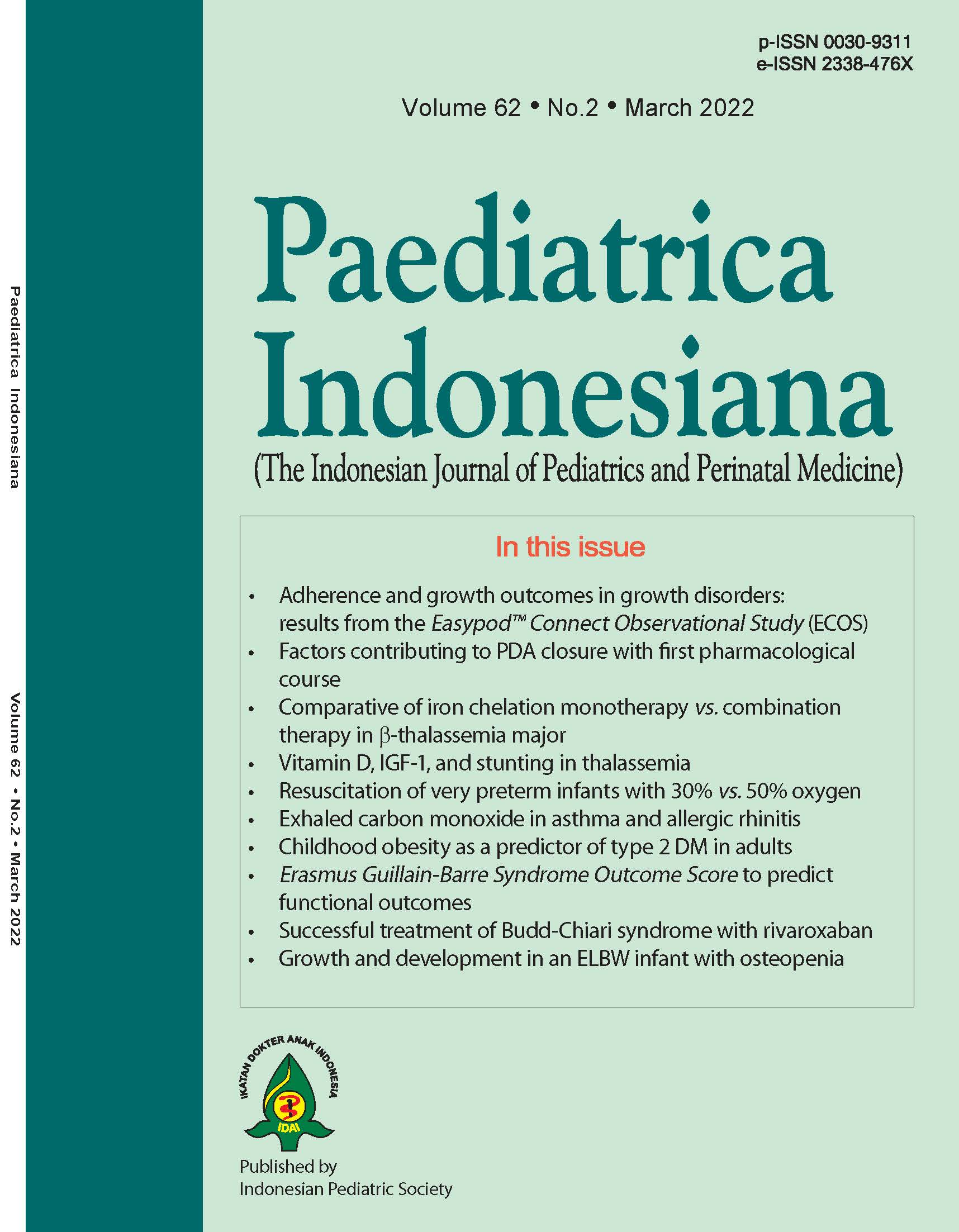Factors contributing to successful patent ductus arteriosus closure with first pharmacological course
Abstract
Background Successful closure of patent ductus arteriosus (PDA) with ibuprofen or paracetamol as the first-line treatment has been reported, but little is known about factors affecting the closure rate.
Objective To identify the closure success rate and contributing factors affecting a first course of pharmacological treatment in neonates with PDA.
Methods A retrospective study was conducted in infants with isolated PDA treated with either ibuprofen or paracetamol and admitted to our neonatal care unit from January 2017 until June 2020. Included infants had PDA on echocardiography and received ibuprofen or paracetamol therapy as the closure treatment. Oral ibuprofen was given at 10 mg/kg on first day, then 5 mg/kg on the 2nd and 3rd days; while paracetamol was given intravenously 15 mg/kg every 6 hours for 3 days. Echocardiographic evaluation was performed 3 days after first course of treatment.
Results In total, 20 of 33 (60.6%) infants achieved PDA closure with the first course of treatment. Earlier age at the start of the first course of treatment (PR 7.7; 95%CI 1.2 to 47.7; P=0.035) and normal birth weight (PR 13.3; 95%CI 2.4 to 72.4; P=0.001) were significant factors contributing to PDA closure. However, PDA size did not affect closure rate (PR 2.0; 95%CI 0.4 to 8.5; P=0.46).
Conclusion Pharmacological treatment seems to have a good success rate for PDA closure, with significant positive associations with earlier age at start of treatment and normal birth weight.
References
2. Ohlsson A, Walia R, Shah SS. Ibuprofen for the treatment of patent ductus arteriosus in preterm and/or low birth weight (or both) infants. Cochrane Database Syst Rev. 2015;2:CD003481. DOI: 10.1002/14651858.CD003481.pub6
3. Van der Lugt NM, Lopriore E, Bokencamp R, Smits-Wintjens VEH, Steggerda SJ, et al. Repeated courses of ibuprofen are effective in closure of a patent ductus arteriosus. Eur J Pediatr. 2012;171:1673–7. DOI: 10.1007/s00431-012-1805-6
4. Kulmacz RJ. Regulation of cyclooxygenase catalysis by hydroperoxides. Biochem Biophys Res Commun. 2005;338:25–33. DOI: 10.1016/j.bbrc.2005.08.030
5. Adriansyah R, Idris NS, Djer MM, Putra ST, Rohsiswatmo R. Intravenous paracetamol and patent ductus arteriosus closure in preterm infants. Paediatr Indones. 2017;57:198-204. DOI:10.14238/pi57.4.2017.198-204
6. Madeleneau D, Aubelle MS, Pierron C, Lopez E, Patkai J, Roze JC. Efficacy of a first course of ibuprofen for patent ductus arteriosus closure in extremely preterm newborns according to their gestational age-specific z-score for birth weight. PloS One. 2015;13:e0124804. DOI: 10.1371/journal.pone.0124804
7. Meena V, Meena DS, Rathore PS, Chaudhary S, Soni JP. Comparison of the efficacy and safety of indomethacin, ibuprofen, and paracetamol in closure of patent ductus arteriosus in preterm neonates-a randomized controlled trial. Ann Pediatr Cardiol. 2020;13:130-5. DOI: 10.4103/apc.APC_115_19
8. Kushnir A, Pinheiro JM. Comparison of renal effects of ibuprofen versus indomethacin during treatment of patent ductus arteriosus in contiguous historical cohorts. BMC Clin Pharmacol. 2011;11:8-15. DOI: 10.1186/1472-6904-11-8
9. Dani C, Poggi C, Mosca F, Schena F, Lista G, Ramenghi L, et al. Efficacy and safety of intravenous paracetamol in comparison to ibuprofen for the treatment of patent ductus arteriosus in preterm infants: study protocol for a randomized control trial. Trials. 2016;17:182. DOI: 10.1186/s13063-016-1294-4
10. Dice JE, Bhatia J. Patent ductus arteriosus: an overview. J Pediatr Pharmacol Ther. 2007;12:138-46. DOI: 10.5863/1551-6776-12.3.138
11. Thébaud B, Michelakis ED, Wu XC, Moudgil R, Kuzyk M, Dyck JRB, et al. Oxygen-sensitive Kv channel gene transfer confers oxygen responsiveness to preterm rabbit and remodeled human ductus arteriosus: implications for infants with patent ductus arteriosus. Circulation. 2004;110:1372-9. DOI: 10.1161/01.CIR.0000141292.28616.65
12. Richards J, Johnson A, Fox G, Campbell M. A second course of ibuprofen is effective in the closure of a clinically significant PDA in ELBW infants. Pediatrics. 2009;124:287–93. DOI: 10.1542/peds.2008-2232
13. Hirt D, Van Overmeire B, Treluyer JM, Langhendries JP, Marguglio A, Eisinger MJ, et al. An optimized ibuprofen dosing scheme for preterm neonates with patent ductus arteriosus, based on a population pharmacokinetic and pharmacodynamic study. Br J Clin Pharmacol. 2008;65:629–36. DOI: 10.1111/j.1365-2125.2008.03118.x
14. Koch J, Hensley G, Roy L, Brown S, Ramaciotti C, Rosenfeld CR. Prevalence of spontaneous closure of the ductus arteriosus in neonates at a birth weight of 1000 grams or less. Pediatrics. 2006;117:1113?21. DOI: 10.1542/peds.2005-1528
15. Tschuppert S, Doell C, Arlettaz-Mieth R, Baenziger O, Rousson V, Balmer C, et al. The effect of ductal diameter on surgical and medical closure of patent ductus arteriosus in preterm neonates: size matters. J Thorac Cardiovasc Surg. 2008;135:78-82. DOI: 10.1016/j.jtcvs.2007.07.027
16. Babaei H, Nemati R, Daryoshi H. Closure of patent ductus arteriosus with oral acetaminophen in preterm neonates: a randomized trial. Biomed Res Ther. 2018;5:2034-44. DOI : 10.15419/bmrat.v5i02.418
17. Lucas R, Warner TD, Vojnovic I, Mitchell JA. Cellular mechanisms of paracetamol: role of cyclooxygenase. FASEB J. 2005;19:635–7. DOI: 10.1096/fj.04-2437fje
18. Coceani F, Baragatti B. Mechanisms for ductus arteriosus closure. Semin Perinatol. 2012;36:92?7. DOI: 10.1053/j.semperi.2011.09.018
19. Green K, Drvota V, Vesterqvist O. Pronounced reduction of in vivo prostacyclin synthesis in humans by acetaminophen (paracetamol). Prostaglandins. 1989;37:311–5. DOI: 10.1016/0090-6980(89)90001-4
20. Rakza T, Magnenant E, Klosowski S, Tourneux P, Bachiri A, Storme L. Early hemodynamic consequences of patent ductus arteriosus in preterm infants with intrauterine growth restriction. J Pediatr. Déc. 2007;151:624?8. DOI: 10.1016/j.jpeds.2007.04.058
Copyright (c) 2022 Dwisri Okadharma

This work is licensed under a Creative Commons Attribution-NonCommercial-ShareAlike 4.0 International License.
Authors who publish with this journal agree to the following terms:
Authors retain copyright and grant the journal right of first publication with the work simultaneously licensed under a Creative Commons Attribution License that allows others to share the work with an acknowledgement of the work's authorship and initial publication in this journal.
Authors are able to enter into separate, additional contractual arrangements for the non-exclusive distribution of the journal's published version of the work (e.g., post it to an institutional repository or publish it in a book), with an acknowledgement of its initial publication in this journal.
Accepted 2022-03-04
Published 2022-03-04













